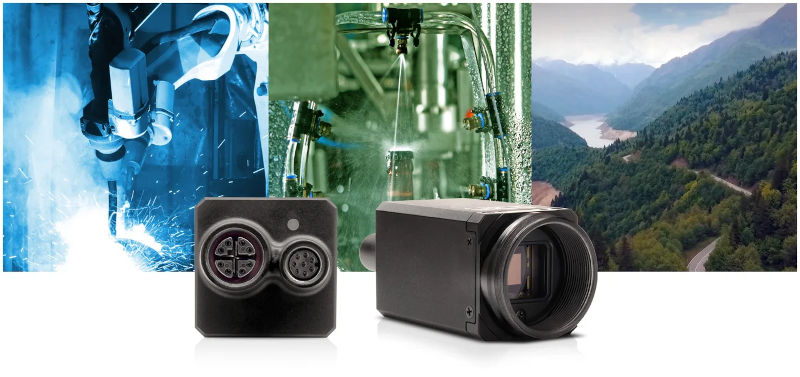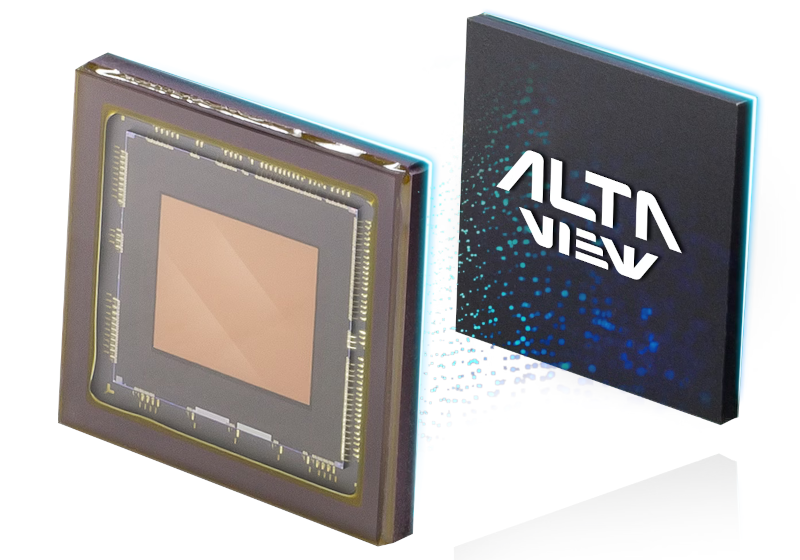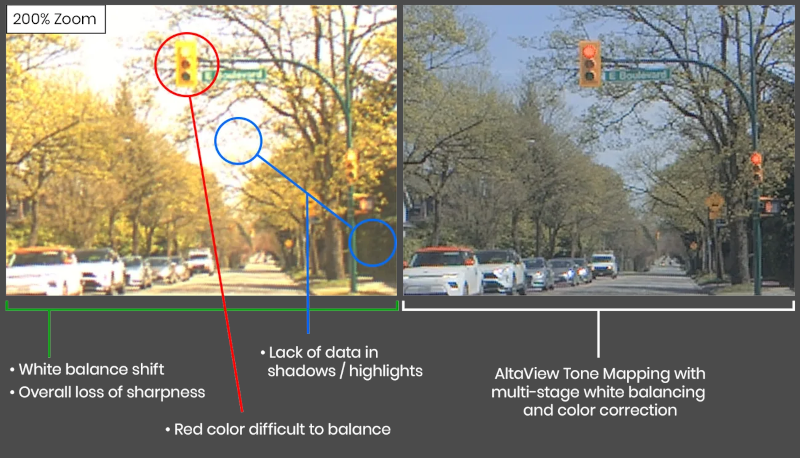|
|
Camera HDR Lucid Triton TDR054S-C
DescriptionFeatures:
Adaptive Tone Mapping - On-Camera 24-Bit RAW to 8-Bit RGB LUCID’s AltaView™ is a specialized on-camera tone mapping engine that works in conjunction with the sensor and ISP to effectively convert 24-bit RAW image streams into 8-bit RGB image streams. Unlike other technologies that apply tone mapping off-camera and utilize lower bit depth image streams, AltaView takes full advantage of the high dynamic range (HDR) offered by specialized HDR sensors such as Sony’s IMX490 CMOS. By performing adaptive tone mapping directly on-camera, AltaView not only delivers low-latency 8-bit images with exceptional detail and color, but also reduces your development time by eliminating the need to create your own tone mapping algorithm.
One of AltaView’s key advantages is its ability to maintain a single fixed exposure setting while its on-camera hardware accelerated adaptive tone mapping algorithm analyzes and combines the most relevant data from the native RAW sensor stream. This intelligent approach ensures that the resulting 8-bit images (available in RGB and YCbCr formats) are rich in color and packed with valuable data in the shadows and highlights. These high-quality images are specifically designed for applications that involve neural networks, mobile sensing AI training, automotive use cases, and advanced driver assistance systems (ADAS). LUCID cameras equipped with the AltaView engine set themselves apart by enabling real-time tone mapping on-camera, maximizing the utilization of HDR sensors, and providing data-rich, full-color 8-bit images suitable for various demanding applications.
Temporal Backward Flow Filtering AltaView’s specialized tone mapping algorithm includes temporal backward flow filtering to specifically remove the chance of brightness flickering and flashing that may arise when tone mapping HDR image streams into 8-bit streams. Without the integration of this filtering, random image frames run the risk of encountering sudden spikes or dips in brightness. The temporal backward flow filtering feature is adjustable by the user and allows AltaView’s algorithm to analyze a rolling set of previous frames. This analysis not only eliminates brightness flickering but also ensures smooth transitions between changes in luminance within a scene. For instance, when entering or exiting a tunnel or passing under bright streetlamps at night, the algorithm maintains smooth and seamless adjustments in luminosity. By incorporating temporal backward flow filtering, AltaView enhances the overall visual quality and consistency of the tone-mapped image streams by eliminated sub-optimal image frames caused by abrupt changes in brightness and luminance.
White Balancing and Color Correction for Color Accuracy and Image Sharpness AltaView’s multi-stage white balancing and color correction results in accurate and consistent color reproduction in the final 8-bit image stream. LUCID’s approach involves two stages of white balancing to ensure accurate color representation before and after tone mapping. Then color correction is applied to further refine color accuracy and eliminate any color shifting that can occur after dynamic range compression and color space compression. This process distinguishes it from many existing tone mapping algorithms that often reduce image sharpness as a side effect of color adjustment.
Designed for Mobile Applications Cameras equipped with the AltaView Tone Mapping engine are ideal for a range of industrial applications that require high-quality imaging and versatile functionality, with a specific focus on autonomous car, mobile robot, and railway/subway inspection. Some of the applications include: Autonomous Cars Reliable and accurate imaging in all lighting conditions, even when driving into the sun, make cameras with AltaView an ideal choice for autonomous vehicles that require precise vision capabilities to operate safely. Mobile Robots AltaView provides exceptional imaging performance making it well-suited for use in mobile robots, allowing for reliable navigation and obstacle detection for smart factories and warehouses even in environments with a mix of indoor and outdoor lighting. Railway / Subway The ability to retain image details and sharpness, along with exceptional imaging performance in all lighting conditions, makes it an ideal choice for railway and subway inspections. 4 Channel 24-Bit RAW: Sony IMX490 CMOS + AltaView AltaView is designed to work with specialized HDR sensors such as Sony’s IMX490 CMOS. The IMX490 HDR sensor is a back-illuminated (BSI) sensor, with wiring located below the photodiode, which helps more light reach the photodiode without obstruction. Each sub-pixel has a differently sized microlens to focus light into the photodiodes, and a light shield and deep trench are implemented to prevent cross-talk and electrical charge leakage between sub-pixels. Sony’s IMX490 CMOS sensor uses sub-pixel technology to achieve HDR processing without any latency between exposures. This technology consists of both large and small pixels with different light sensitivities, each read out with high and low conversion gains, resulting in four 12-bit channels per pixel. The exposures are set to the same length and take place simultaneously, allowing the four channels to be combined on-sensor into a single linear 24-bit HDR value. An additional benefit of having simultaneous exposures is LED flicker mitigation. This provides the AltaView engine with high quantum efficiency, 120dB dynamic range 24-Bit RAW image data from a combined sub-pixel saturation capacity of 120,000 e-. 
Zooming into the sensor reveals two different size pixels Ease of Use - Adjustable Fixed Exposure Cameras with AltaView need only one exposure setting. By setting the camera to a fixed exposure time in all conditions, development time and integration become simpler. With AltaView, users can enjoy a hassle-free operation, eliminating the need for separate settings for auto exposure, auto gain, white balance, CCM, LUTs, or the effort required to build a tone mapping algorithm on the host PC.
All you need to set is:
No need to worry about:
24/7 Industrial Reliability LUCID’s Triton IP67 camera provides the perfect home for AltaView. All Triton units are engineered and rigorously tested to offer superior quality and stability for 24/7 streaming in challenging environments. 
IP67 Protection:
Industrial EMC Immunity:
M12 and M8 Connectors:
Die-cast Aluminium Case:
100 m Cable Length:
Shock and Vibration: Technical specification
DocumentsSoftware |
|










